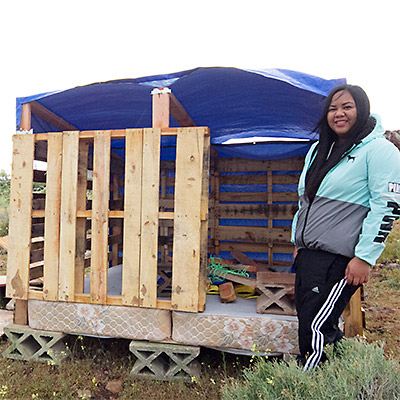
During Spring Semester, architecture students design and build structures in the annual "Build on the Hill" event at Truckee Meadows Community College.
“Synergy is what happens when one plus one equals ten or a hundred or even a thousand,” said Stephen Covey as quoted on BrainyQuote.com.
For Fall Semester 2016, Architecture and Construction Technologies faculty members at TMCC are progressing toward even better synergy for both programs at a time when the needs for workers in these areas are rapidly growing.
Architecture classes will move from the Dandini Campus to the newly remodeled William N. Pennington Applied Technology Center (ATC) on Edison Way in August. The move gives the program access to sophisticated equipment at the Center and improves interaction with other technical programs.
“We’ll be able to work with the machining program to use computer numerical control (CNC) machines, when building models,” said Kreg Mebust, Instructor of Architecture. “We also will have the CAD labs with dual monitors, greatly benefiting students when working in CAD software systems.”
Mike Holmes, Construction Technologies Professor agrees.
“Architecture students will also have the use of a digitizer that records their drawings to digital files,” he said. “Digitized drawings are used in estimating project quantity, as the linear area translates into cost and supply estimates.”
Jim New, Dean of Technical Sciences said that the move and program updates are driven by input from industry.
“We’re not only working to make the programs more efficient and cost effective, but to enhance the curriculum in response to industry needs, both residential and commercial, across the board,” he said.
Mebust also agrees.
“These changes are highly supported by the Architecture Advisory Committee,” he said.
More synergy for Dual Credit Programs
“Moving and consolidating programs also makes these areas of study available to the dual enrollment programs we’re establishing with both Washoe County School District and ACE Charter High School,” New said.
The high school programs start in Fall Semester 2016, and applications are due by July 29.
“We worked with Washoe County School District to create a Technical Pathway option for students in their junior and senior years of high school,” said Gretchen Sawyer, Executive Director of the TMCC Foundation. “It’s a dual-credit system where the students will add technical coursework to their curriculum and graduate with a high school diploma in one hand and a college certificate of achievement or skills certificate in the other.”
New said an identical agreement has also been established for students attending ACE Charter High School.
The certificates include programs in architecture, construction management, welding, automotive, advanced manufacturing, and many others.
Faculty are interacting, growing the programs and working on stackable credentials
In addition to the physical proximity between the programs, architecture and construction management faculty have also worked together developing the new Construction and Design Associate of Applied Science degree that has been submitted for approval to the Nevada System of Higher Education (NSHE). The degree program will begin in Fall 2017, pending approval by the NSHE Academic Affairs Council.
Also, many of the programs in technical sciences are stackable, which means a student can take a sequence of job-specific technical courses to earn a skills certificate and then enter the workforce or add these credits into the next level of education.
One example is in construction management. Students may complete one or both of the skill certificates, and enter the workforce:
- Construction Project Management: 18 credits
- Construction Project Estimating: 18 credits
Or, students can continue their education toward the Associate of Applied Science Degree in Construction Technologies, Construction Management Emphasis.
Synergy for the region’s employers
An Occupational Safety and Health Administration (OSHA) 30-hour training is offered by TMCC at the ATC. The training is required when an employee moves into a supervisory role in many construction technologies career fields. Taking the course while in college enables a graduate to be ready to supervise without returning to school to start the initial OSHA training.
“This is a benefit to employers, as well, because in the past they would need to send an employee back to school for an OSHA certificate in order to be legally able to supervise, and that’s lost time on the job and in training costs,” he said. “All together, costs can add up to more than $2,000.”
New agrees, adding that the resurgence in the economy is already creating demand for positions in architectural and construction technologies occupations throughout Northern Nevada.
“We’re working closely with local professional and trade associations to develop courses and programs that meet the needs of employers,” New said.
To find information or an application to Technical Pathway, and more about TMCC Architecture or Construction Technologies Programs, please call 775-856-5300.






